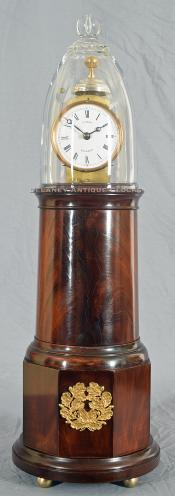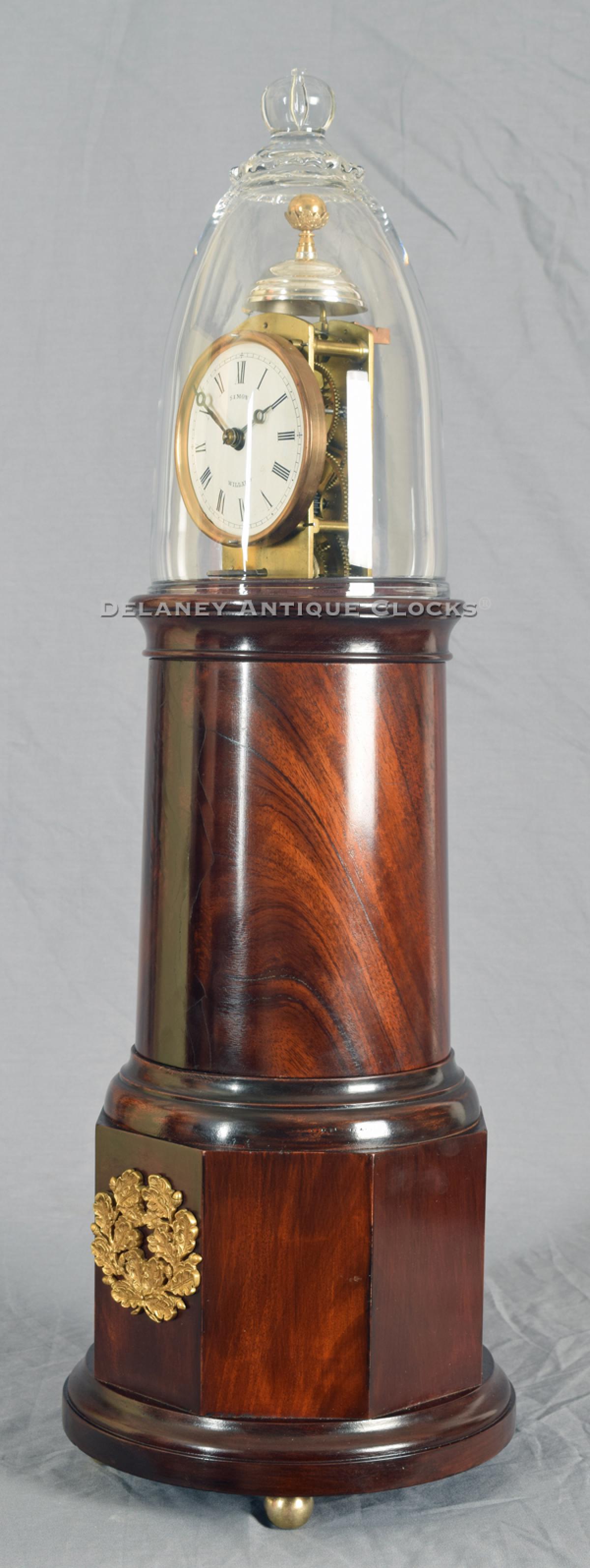Simon Willard of Boston, Massachusetts. This is a high-quality reproduction of Simon Willard's Lighthouse Clock. 220073.
This well-made example is a faithful reproduction of Simon Willard's lighthouse clock. Much of this case is constructed with period wood. As a result, the veneers exhibit a vibrant grain pattern, and many interior surfaces show appropriate oxidation and age. In addition, the form is excellent. It has a very engaging presence.
Simon Willard introduced the lighthouse clock form as a variation of the shelf clock. Its appeal, beyond the unusual case form, has to be the accessibility of the mechanism. Placing the works under a glass dome allowed the viewer to see a clock mechanism's internal workings and motions. The ability to view the internal workings of a clock mechanism must have been fascinating. Shortly after their introduction, a variety of movement configurations were employed. The alarm is often associated with this form because of Simon's advertisement in 1822. Simon advertised in the Boston newspaper his newly patented alarm with an illustration of the lighthouse clock form. Simon was granted a patent for an alarm mechanism in 1822. This clock form was well suited to illustrate this device. Based on the lighthouse examples known to survive, the variation in case presentations suggests that they were made individually. The glass dome mounted to the top of the case was integral to the design of the case. The glass dome also provided a cover for the movement and protected it from dust. The designs of these movements from one example to another exhibit a number of variations. The vast majority appear to have been constructed as timepieces. The next category features the timepiece design fitted with a passing strike. Others were designed with an alarm mechanism added to the left side of the works. The alarm hammer could be set up to strike a bell, usually mounted above the movement, or to rap on the wooden case. Another visually attractive setup choice was the inclusion of a rocking ship. The ship is displayed above the dial and moves side to side with the pendulum's motion. Today, the original clocks are highly prized by collectors. As a result, the original form has been reproduced by a number of people.
This hand-built case is raised on feet. The front two feet are in the form of brass balls that are applied to the bottom of the case, adding a touch of elegance. The third foot, the back foot, is constructed of wood. The base section of this example is constructed in the form of an octagon. An ormolu mount in the form of a victory wreath is mounted on the front panel. A skillfully turned molding transitions the octagon form to a tapered circular waist section. This large cylinder features a quality selection of crotch mahogany veneer. A shaped molding forms the mounting platform for the distinctive glass dome. This dome is removable so that one can access the movement and dial.
A decorative brass bezel secures the enamel slightly convex dial to the movement. The time ring features a closed minute ring, and the hours are marked with Roman-style figures. The front surface of this dial provides excellent contrast between the black hands and the dial surface. This dial is signed with Simon Willard's name in a blocked font.
The time-only movement is constructed in brass and designed to run for eight days on a full wind. It is powered by a heavy lead weight that descends through the center of the case directly below the movement. Four turned posts support two large rectangular plates rounded at the top. Steel shafts suspend the brass gearing. The pinions are hardened and turned smooth. The escapement is a recoil design, and the pendulum hangs from the back of the movement suspended on a post. This clock is fitted with a passing strike. A hammer will strike the bell mounted above the movement once each hour. The tension in the fitted coil spring returns it to the ready position.
It is my guess that this clock was made 50 to 100 years ago. This clock measures approximately 28.5 inches tall to the top of the glass dome. It is 9.25 inches wide and 9.25 inches deep. It is very well made.
Inventory number 220073.








